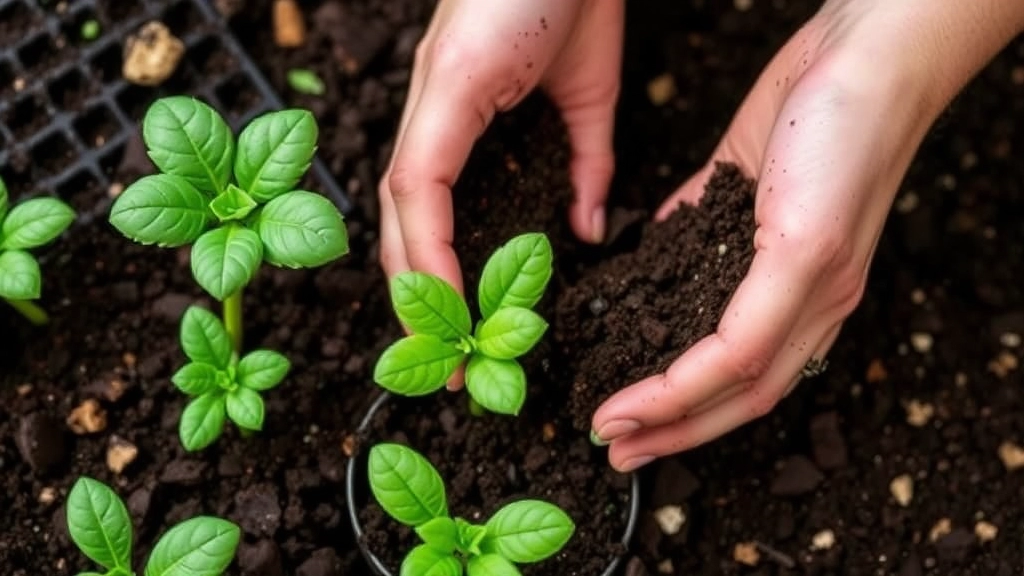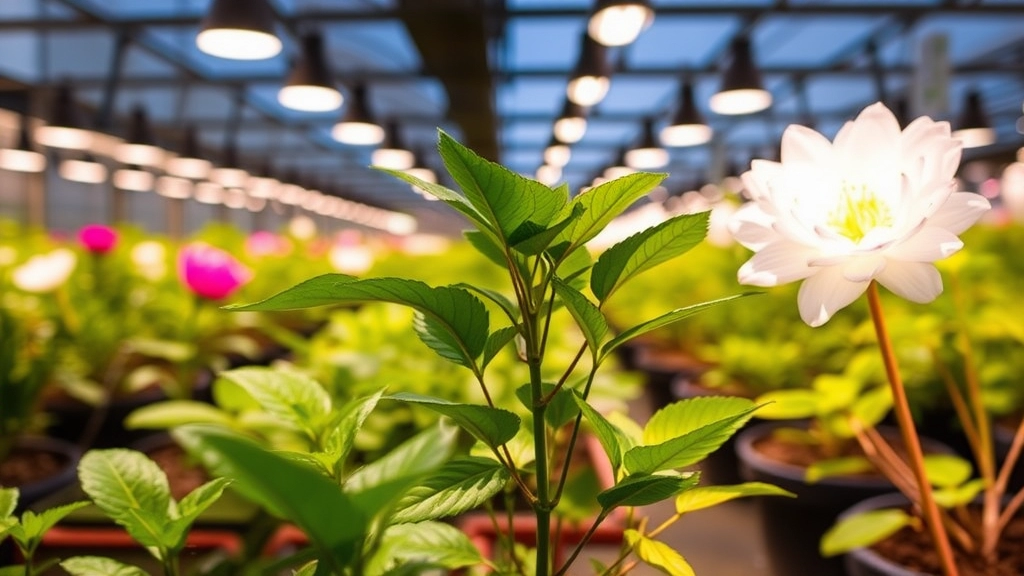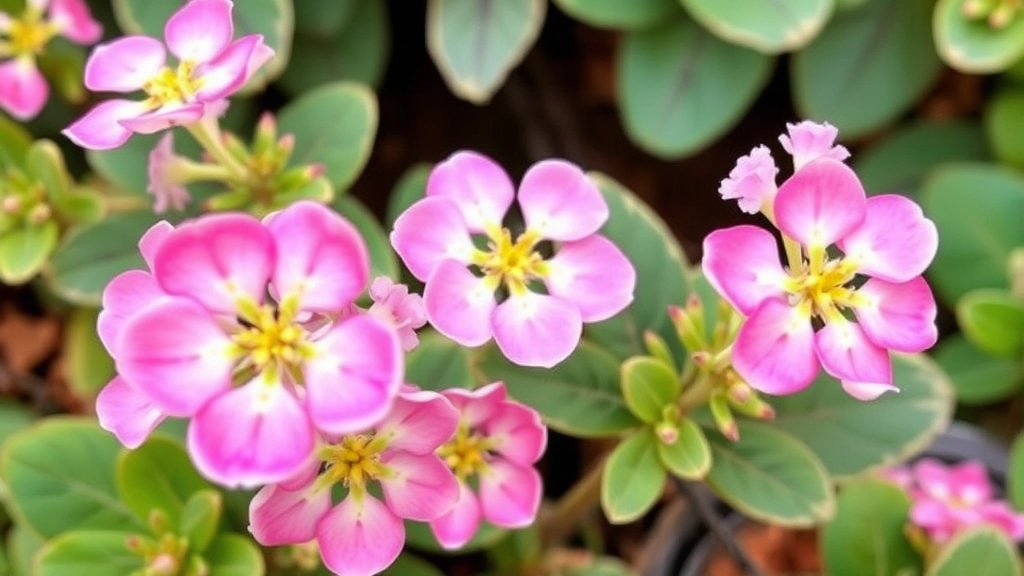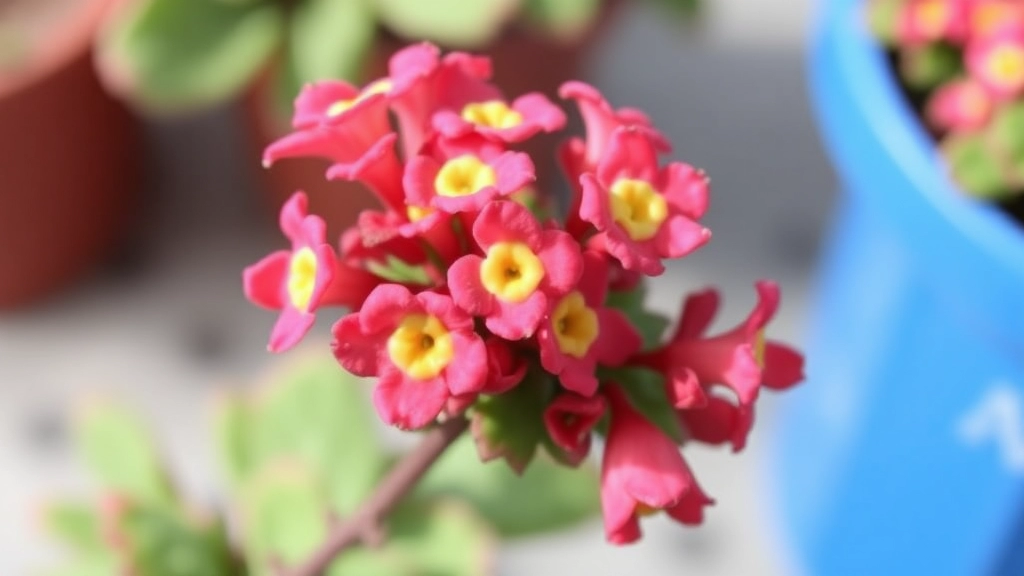Flowering Kalanchoe Guide
Flowering Kalanchoe, also known as Kalanchoe Blossfeldiana, is a popular choice for both novice and experienced gardeners. This vibrant succulent is cherished for its long-lasting blooms and minimal care requirements. In this guide, I’ll share practical tips on how to care for your Kalanchoe Blossfeldiana, ensuring it thrives and blooms beautifully in your home or garden.
Understanding Care Basics
To start, understanding the basics of soil and watering is crucial. Kalanchoe Blossfeldiana prefers well-draining soil and a careful watering schedule to prevent root rot. Additionally, providing the right light and temperature conditions will promote optimal blooming. Stay tuned as we delve into these aspects and more, helping you maintain a healthy and flourishing Kalanchoe.
How to Care for Kalanchoe Blossfeldiana Indoors
Are you wondering how to keep your Kalanchoe Blossfeldiana thriving indoors?
Caring for this stunning succulent can be a delightful experience, but it does come with its own set of challenges.
Here’s a straightforward guide to ensure your Kalanchoe remains vibrant and healthy.
Best Soil Mix and Potting Techniques for Healthy Growth

So, you’ve got your Kalanchoe Blossfeldiana and you’re wondering, “What kind of soil does my plant need?”
Choosing the Right Soil Mix
The right soil mix can make all the difference in keeping your Kalanchoe happy and thriving.
- Well-Draining Soil: Kalanchoes prefer a soil that drains well. A cactus or succulent mix is perfect for this.
- Add Perlite or Sand: To improve drainage, mix in some perlite or coarse sand. This helps prevent root rot, which is a common issue with these beauties.
- pH Level: Aim for a slightly acidic to neutral pH, around 6.0 to 7.0.
Potting Techniques
Now that you’ve got your soil sorted, let’s talk about potting.
- Choose the Right Pot: Make sure your pot has drainage holes. This is crucial for preventing water from sitting at the bottom, which can lead to root rot.
- Size Matters: Pick a pot that’s just a bit larger than the current one. Too big and the soil might stay too moist.
- Layering: Start with a layer of small stones at the bottom before adding your soil mix. This adds extra drainage.
Re-potting Tips
If your Kalanchoe is getting a bit cramped, it might be time to re-pot.
- When to Re-pot: Look for signs like roots coming out of the drainage holes or stunted growth.
- Gentle Handling: When re-potting, be gentle with the roots. Shake off some old soil, but don’t go overboard.
Watering Guidelines: Preventing Root Rot in Kalanchoe
One of the most common concerns for Kalanchoe owners is ensuring their plants receive the right amount of water. Overwatering can lead to root rot, a serious condition that can jeopardise the health of your beloved Kalanchoe.
Key Watering Tips
- Check the Soil: Before watering, always check the soil moisture. Stick your finger about an inch into the soil. If it feels dry, it’s time to water. If it’s still moist, wait a few more days.
- Water Thoroughly: When it’s time to water, do so thoroughly. Ensure that water drains out of the bottom of the pot. This promotes healthy root growth and prevents stagnation.
- Use Well-Draining Soil: A soil mix designed for succulents or cacti is ideal. This helps excess water to escape and reduces the risk of root rot.
- Frequency: Generally, Kalanchoe requires watering every 2-3 weeks. However, this may vary based on your home’s humidity and temperature.
- Seasonal Adjustments: In the growing season (spring and summer), your Kalanchoe may need more frequent watering. In contrast, during the dormant months (autumn and winter), reduce watering significantly.
Signs of Overwatering
- Yellowing Leaves: If you notice your Kalanchoe’s leaves turning yellow, it may be a sign of overwatering. For more detailed care, check out our Yellow Kalanchoe Blossfeldiana Care Guide.
- Soft, Mushy Stems: This is a clear indicator that your plant is struggling with excess moisture.
- Foul Odour: A rotten smell from the pot suggests root rot has set in. Learn how to address this issue in our Etiolated Kalanchoe Blossfeldiana Lighting and Care Tips.
By following these simple guidelines, you can help your Kalanchoe thrive while preventing the dreaded root rot.
Light and Temperature Requirements for Optimal Blooming

When it comes to nurturing your Kalanchoe Blossfeldiana, understanding its light and temperature needs is essential for achieving those stunning blooms. Are you worried about your plant not flowering as it should? You’re not alone. Many enthusiasts face this challenge, but with the right conditions, your Kalanchoe can thrive.
Light Requirements
Kalanchoe loves bright, indirect sunlight. Here are some tips to ensure your plant gets the right amount of light:
- Ideal Positioning: Place your Kalanchoe near a south or west-facing window for optimal light exposure.
- Avoid Direct Sun: While it enjoys light, too much direct sunlight can scorch its leaves. Filtered light is best.
- Supplemental Lighting: If natural light is limited, consider using grow lights to mimic the sun’s rays.
Temperature Conditions
Temperature plays a crucial role in the blooming cycle of Kalanchoe. Here’s what to keep in mind:
- Optimal Range: Ideally, maintain temperatures between 18°C to 24°C (65°F to 75°F) during the day.
- Nighttime Coolness: A slight drop in temperature at night can encourage blooming, so aim for around 15°C (59°F).
- Avoid Extremes: Protect your Kalanchoe from drafts, sudden temperature changes, and frost, as these can hinder its growth.
By providing the right light and temperature conditions, you set the stage for a beautiful display of flowers.
How to Propagate Kalanchoe: From Cuttings to Seeds
Have you ever wondered how to expand your Kalanchoe collection without spending a fortune?
Propagating Kalanchoe is not only rewarding but also quite straightforward.
Seasonal Blooming: Encouraging Reblooming in Kalanchoe

Have you ever wondered why your Kalanchoe isn’t blooming as much as you’d like?
Don’t worry, you’re not alone.
Getting your Kalanchoe Blossfeldiana to rebloom can feel tricky, but it’s totally doable with the right care.
Here are some simple, effective tips to encourage those stunning flowers to pop up again:
1. Light It Up
- Bright, Indirect Light: Kalanchoe loves light but can’t handle harsh direct sunlight.
- Location Matters: A south-facing window is ideal.
2. Temperature Control
- Keep It Cozy: Aim for temperatures between 18-24°C (65-75°F).
- Avoid Drafts: Sudden temperature changes can stress your plant.
3. Watering Schedule
- Let It Dry: Allow the soil to dry out between waterings to prevent root rot.
- Water Sparingly: During the blooming season, water less frequently.
4. Fertilisation
- Use Balanced Fertiliser: A balanced, water-soluble fertiliser every 4-6 weeks during the growing season can work wonders.
- Stop During Dormancy: Cut back on fertilising when it’s not blooming.
5. Pruning Strategy
- Cut Back After Blooming: Once the flowers fade, trim back the spent blooms and any leggy growth.
- Encourage New Growth: This helps to promote bushier growth and more blooms.
6. Rest Period
- Give It a Break: After blooming, let your Kalanchoe rest for a few weeks.
- Reduce Watering: Water less frequently to mimic its natural dormancy.
Common Pests and Diseases: Prevention and Treatment
As we delve deeper into the care of Kalanchoe, it’s essential to address a concern that many indoor gardeners face: pests and diseases. These can pose a real threat to the health of your plant, but with the right knowledge, you can keep your Kalanchoe thriving.
Pruning and Maintenance Tips for a Bushier Kalanchoe
Ever looked at your Kalanchoe and thought it could use a little more fluff? You’re not alone! Many of us want that lush, bushy look for our indoor plants.
Pruning is key to achieving that fuller appearance. Here’s how to do it right:
- Timing is Everything: The best time to prune your Kalanchoe is right after it blooms. This way, you’re encouraging new growth while keeping the plant healthy.
- Use Sharp, Clean Tools: Always grab a pair of sharp scissors or pruning shears. Clean cuts help prevent disease.
- Cut Back Wisely: Focus on removing dead or wilted leaves first. Then, trim back the stems to about one-third of their height. This encourages new growth and makes the plant bushier.
- Pinch for Growth: If you want to encourage branching, pinch off the tips of the stems. This simple act can lead to a fuller plant.
- Monitor Regularly: Keep an eye on your Kalanchoe. If you notice any leggy growth, don’t hesitate to trim it back.
- Feed After Pruning: After you’ve given your plant a good trim, consider a light feed with a balanced fertiliser. This helps it bounce back stronger.
By following these tips, you’ll not only have a bushier Kalanchoe but also a healthier one. For more detailed advice, check out our complete care guide for Kalanchoe Blossfeldiana. Additionally, if you encounter any issues with your plant’s leaves, our leaf care tips and troubleshooting guide can be incredibly helpful.
FAQs on Flowering Kalanchoe (Kalanchoe Blossfeldiana)
What type of soil is best for Kalanchoe Blossfeldiana?
The best soil for Kalanchoe Blossfeldiana is well-draining soil. A cactus or succulent mix is ideal. Adding perlite or coarse sand can further improve drainage and prevent root rot. Aim for a slightly acidic to neutral pH, around 6.0 to 7.0.
What kind of pot should I use for my Kalanchoe?
Choose a pot with drainage holes to prevent water from sitting at the bottom, which can lead to root rot. The pot should be just a bit larger than the current one to avoid excess moisture retention. A layer of small stones at the bottom can add extra drainage.
How often should I re-pot my Kalanchoe?
Re-pot your Kalanchoe when you notice signs like roots coming out of the drainage holes or stunted growth. Handle the roots gently and shake off some old soil without overdoing it.
What are the light requirements for Kalanchoe Blossfeldiana?
Kalanchoe loves bright, indirect sunlight. Place it near a south or west-facing window for optimal light exposure. Avoid direct sunlight as it can scorch the leaves. If natural light is limited, consider using grow lights.
What temperature conditions are ideal for Kalanchoe?
Maintain temperatures between 18°C to 24°C (65°F to 75°F) during the day. A slight drop in temperature at night, around 15°C (59°F), can encourage blooming. Protect the plant from drafts, sudden temperature changes, and frost.
How can I encourage my Kalanchoe to rebloom?
Encouraging reblooming involves several steps:
- Light: Provide bright, indirect light. A south-facing window is ideal.
- Temperature: Keep temperatures between 18-24°C (65-75°F) and avoid drafts.
- Watering: Allow the soil to dry out between waterings to prevent root rot. Water less frequently during the blooming season.
- Fertilisation: Use a balanced, water-soluble fertiliser every 4-6 weeks during the growing season. Stop fertilising during dormancy.
- Pruning: Trim back spent blooms and any leggy growth after flowering to encourage bushier growth and more blooms.
- Rest Period: Let your Kalanchoe rest for a few weeks after blooming and reduce watering to mimic its natural dormancy.
Can I use supplemental lighting for my Kalanchoe?
Yes, if natural light is limited, you can use grow lights to mimic the sun’s rays and ensure your Kalanchoe gets enough light.
What should I do if my Kalanchoe’s leaves are getting scorched?
If the leaves are getting scorched, it means the plant is receiving too much direct sunlight. Move it to a location with filtered light or use a sheer curtain to diffuse the sunlight.
How do I know if my Kalanchoe needs re-potting?
Signs that your Kalanchoe needs re-potting include roots coming out of the drainage holes or stunted growth. These indicate that the plant has outgrown its current pot and needs more space.
Is it normal for Kalanchoe to have a rest period?
Yes, it is normal for Kalanchoe to have a rest period after blooming. During this time, reduce watering and allow the plant to rest for a few weeks to mimic its natural dormancy cycle.
References
-
Kalanchoe Plant Care: How To Grow A Flowering Kalanchoe
-
How to Grow Kalanchoe (Widow’s-thrill) Indoors
-
Kalanchoe: How to Care for Kalanchoe Plants
